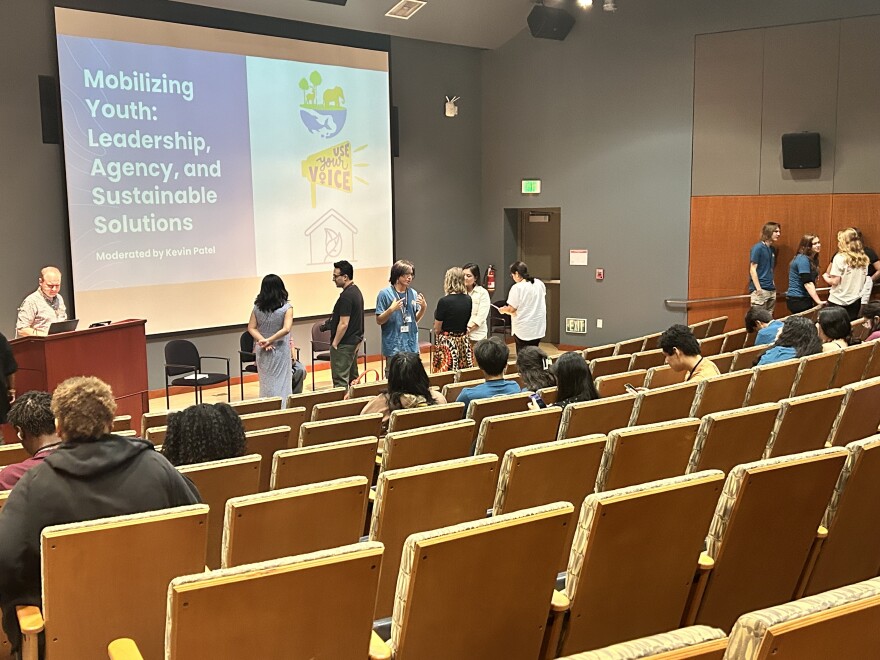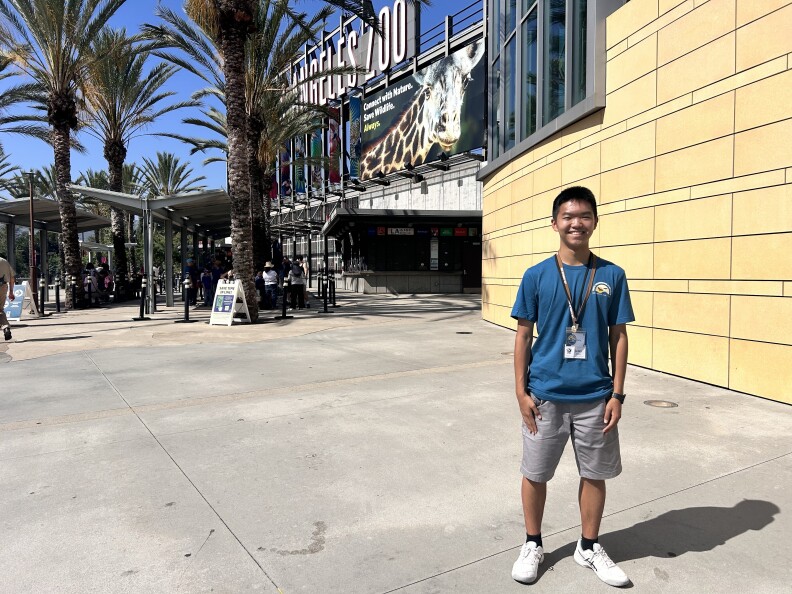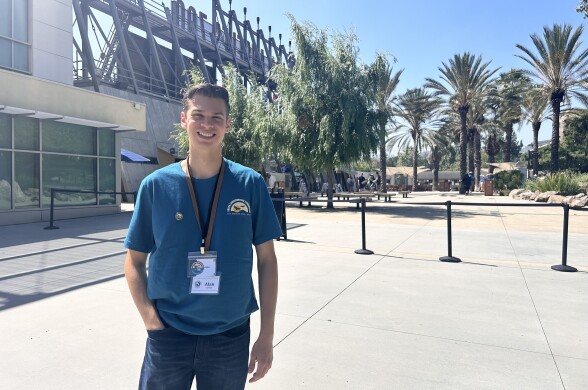Congress has cut federal funding for public media — a $3.4 million loss for LAist. We count on readers like you to protect our nonprofit newsroom. Become a monthly member and sustain local journalism.
How LA teens are teaming up to shape their communities' environmental future

Teenagers in Los Angeles are often inundated with information about climate change, but there are few tangible opportunities for young people to help solve them, especially as each corner of the city experiences the environmental impacts in different ways.
Jerry Yang, a 15-year-old from the North Hollywood area who’s headed into his junior year of high school, was among them. After the Aliso Canyon gas leak forced his family to live out of a hotel for several months and uprooted his time in elementary school, he became interested in environmental advocacy and started organizing other students at school.
“I just thought, like, ‘how can they impact so many communities, have all these symptoms happening to so many kids, and just get away with it’,” he said.
That early experience motivated him to find ways to help his community and those around him, he said, and that’s the mission Yang brought to the L.A. Zoo’s inaugural Youth Conservation Symposium on Saturday.
Teenagers from across the city flocked to Griffith Park to discuss ways to make the city more sustainable and environmentally just. The symposium was organized by the zoo’s Teen Council for Conservation, which includes 30 high school students from nearly every city council district, to connect with other young people and brainstorm action on issues that are important to their generation, such as heat in the school system and biodiversity.
Although most are too young to vote or open their own bank accounts, the teens have big ideas for the environmental issues they see in their communities.

The next generation’s Los Angeles
Satenik Ayrapetyan, a 17-year-old incoming high school senior who lives in the Van Nuys area, told LAist she’s been passionate about the environment since she was told “the world was on fire in third grade” but she struggled to find a way to get involved — until she found the teen council.
Throughout the past nine months of bi-weekly meetings with the other teens, a conservation field trip to Catalina Island, and hearing from a guest speaker all the way in Zimbabwe, Ayrapetyan said she’s learned the sheer importance of community and collaboration.
“You can't create an equal society that, like, benefits the environment without hearing every single person's perspective on how we can change the world, because we don't want to exclude people,” she said. “That's the most important thing. I feel a lot of conservation, especially in the United States, a lot of it has been exclusionary to people of color, to indigenous people especially.”
To make sure a variety of voices were included in the symposium, Ayrapetyan said she and the other teens created a note card heart with topics they wanted to cover, including climate action in schools, making cities more green, and how to connect with as many people as possible “to make sure that we have a future to live for.”
Olinda Fabian, who lives in Watts and recently finished her freshman year of high school, told LAist there’s not a lot of nature in her neighborhood, and the park she does have access to is often littered with dead plants or trash.
Among the teens, it’s been Fabian’s job to advocate for her community, and she said she made sure to talk about a lack of “third places.”
“I know that, like, if we work together, I know we can make a difference and create more nature and third places for people to go to,” she said.
Anna Becker, the L.A. Zoo’s community conservation coordinator who helped the teens put together the symposium, told LAist the event started as a way for young people to take action.
But Becker said she’s been astounded with how they’re doing and what they’re thinking about at this age, and she’s learned a thing or two from the teens too.
“They know a lot, they are aware of a lot, and they're taking on a lot,” she said. “We need to do better, you know, to support them, and to take some of that load off, and work together more to impact the change that they really want to see. I think their vision of what a just and sustainable Los Angeles is means that there is a lot of work for us to do, and I think we should be listening to them.”
As Editor-in-Chief of our newsroom, I’m extremely proud of the work our top-notch journalists are doing here at LAist. We’re doing more hard-hitting watchdog journalism than ever before — powerful reporting on the economy, elections, climate and the homelessness crisis that is making a difference in your lives. At the same time, it’s never been more difficult to maintain a paywall-free, independent news source that informs, inspires, and engages everyone.
Simply put, we cannot do this essential work without your help. Federal funding for public media has been clawed back by Congress and that means LAist has lost $3.4 million in federal funding over the next two years. So we’re asking for your help. LAist has been there for you and we’re asking you to be here for us.
We rely on donations from readers like you to stay independent, which keeps our nonprofit newsroom strong and accountable to you.
No matter where you stand on the political spectrum, press freedom is at the core of keeping our nation free and fair. And as the landscape of free press changes, LAist will remain a voice you know and trust, but the amount of reader support we receive will help determine how strong of a newsroom we are going forward to cover the important news from our community.
Please take action today to support your trusted source for local news with a donation that makes sense for your budget.
Thank you for your generous support and believing in independent news.

-
The U.S. Supreme Court lifted limits on immigration sweeps in Southern California, overturning a lower court ruling that prohibited agents from stopping people based on their appearance.
-
Censorship has long been controversial. But lately, the issue of who does and doesn’t have the right to restrict kids’ access to books has been heating up across the country in the so-called culture wars.
-
With less to prove than LA, the city is becoming a center of impressive culinary creativity.
-
Nearly 470 sections of guardrailing were stolen in the last fiscal year in L.A. and Ventura counties.
-
Monarch butterflies are on a path to extinction, but there is a way to support them — and maybe see them in your own yard — by planting milkweed.
-
With California voters facing a decision on redistricting this November, Surf City is poised to join the brewing battle over Congressional voting districts.









